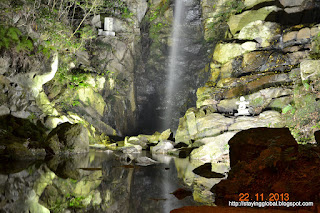Last week, while watching the evening news on NHK I came across a coverage of the autumn foliage illumination in and around Nagoya. The visuals of the illumination at Iwayado Park in Seto city were breathtaking and I made up my mind -this was a spot that we had to visit over the weekend. On Friday evening, our family along with our family friends decided to visit the Iwayado park.
Iwayado park is a scenic spot located in the Aichi Kogen Quasi National Park. The natural scenery can be enjoyed in all four seasons but the best times to visit are in spring for cherry blossoms and Autumn for the foliage.What makes this place more beautiful in the autumn is the reflection of the fall colours in the still waters of the Torihara river.
The news coverage specially mentioned that the park maintenance team does a great task of cleaning of the water for any fallen leaves so that visitors are not disappointed with fallen leaves spoiling the reflection.
The park is illuminated in the evening between 5:30 and 9:00 pm and this attracts visitors from the surrounding areas.
Iwayado is short for Iwayayama Yakushido and is a part of the inner sanctuary of the Jogenji Temple.
It is said that in 725 AD, three Buddhist statues were carved inside a cave to pray for Emperor Shomu's recovery from illness and the temple was established later to offer gratitude upon his recovery.
The Gyomyo-ga-taki waterfall flows just behind the Iwayado temple.
The path leading to the Iwayado temple and the Gyomyo-ga-taki are also illuminated.
The park has many walkways, unusual rock formations, caves and waterfalls and is a good place to spend a day. The park also has a day barbecue area. We are definitely going back there in spring !
Address : Iwayacho, Seto, Aichi Prefecture 480-1215, Japan
Entrance fee: Free
Parking: Free parking available for 100 units.
Autumn Foliage: Best time to visit is mid to end November.
Autumn illumination : 5:30 pm to 9:00 pm
( in 2013 the autumn illumination was done till 24th November).
Iwayado park is a scenic spot located in the Aichi Kogen Quasi National Park. The natural scenery can be enjoyed in all four seasons but the best times to visit are in spring for cherry blossoms and Autumn for the foliage.What makes this place more beautiful in the autumn is the reflection of the fall colours in the still waters of the Torihara river.
The news coverage specially mentioned that the park maintenance team does a great task of cleaning of the water for any fallen leaves so that visitors are not disappointed with fallen leaves spoiling the reflection.
The park is illuminated in the evening between 5:30 and 9:00 pm and this attracts visitors from the surrounding areas.
Iwayado is short for Iwayayama Yakushido and is a part of the inner sanctuary of the Jogenji Temple.
It is said that in 725 AD, three Buddhist statues were carved inside a cave to pray for Emperor Shomu's recovery from illness and the temple was established later to offer gratitude upon his recovery.
The Gyomyo-ga-taki waterfall flows just behind the Iwayado temple.
The path leading to the Iwayado temple and the Gyomyo-ga-taki are also illuminated.
The park has many walkways, unusual rock formations, caves and waterfalls and is a good place to spend a day. The park also has a day barbecue area. We are definitely going back there in spring !
Address : Iwayacho, Seto, Aichi Prefecture 480-1215, Japan
Entrance fee: Free
Parking: Free parking available for 100 units.
Autumn Foliage: Best time to visit is mid to end November.
Autumn illumination : 5:30 pm to 9:00 pm
( in 2013 the autumn illumination was done till 24th November).
























































